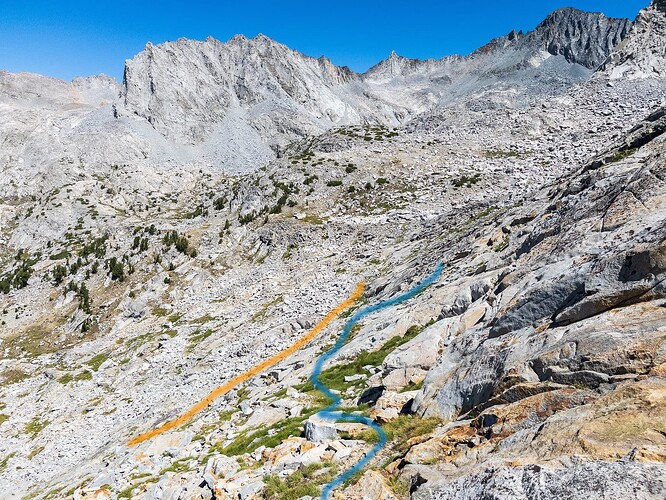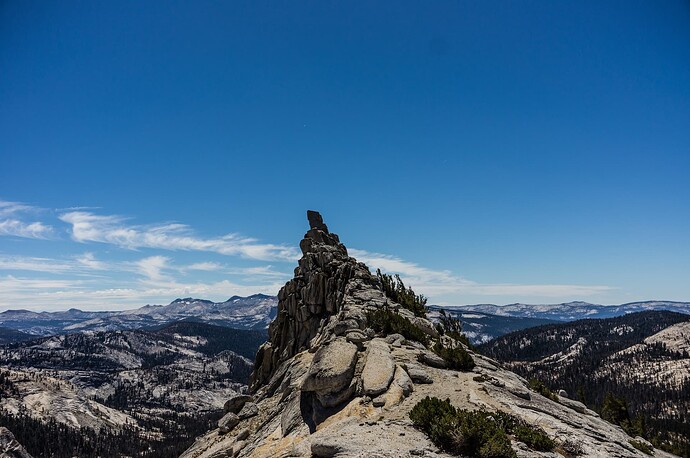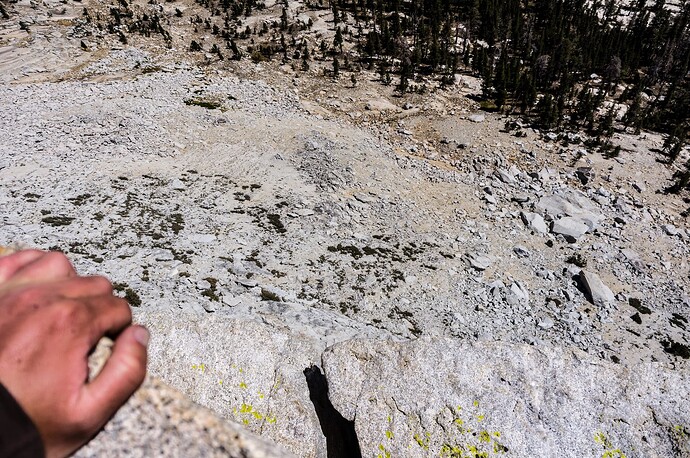Overview
One issue with sac_scale is that it covers both difficulty and exposure (and makes some other assumptions that can be disregarded). If a trail is T1 in technique, but T3 in exposure, it should be tagged as T3. However anyone looking at that tag has no idea if it’s partially or completely T3 terrain.
They might be fine with being on a trail that is near the edge of a cliff but dirt single track, but not on a T3 technique with T3 exposure trail.
As a real world use case my partner and I, in standard hiking/backpacking shoes/boots are more comfortable with exposure the less technique there is. It’s uncommon, but not that much of an edge case for a T2 technique path to have a T4 level of exposure. T2 exposure and T4 technique is fun, T4 exposure and T2 terrain is perfectly fine as long as it’s reasonably trustworthy, but they are different from T4 terrain and T4 exposure (which I’d have to tag it as with the existing system).
As my partner put it:
Yeah it’s where disambiguating exposure and technical difficulty is the difference between “if you don’t like heights you’ll hate this but a 5 year old can do it” and “there’s a chance you could die if you don’t know what you’re doing"
I basically had this written up for another project, so I’d propose borrowing the US Yosemite Decimal System movie star rating for protection while climbing and applying it to exposure as it’s probably easier for the average person to understand. At least were a similar movie rating system exists, but I assume Hollywood movies make it to most places.
Note: this pairs well with hiking_technique. ![]()
Class 5 has “movie rating” risk modifiers regarding the distance between aid placement - for unroped travel in simpler terrain they will refer to the general risk associated with a fall due to exposure. It’s worth noting that you can sprain your ankle stumbling in a parking lot or crack your head open tripping on a sidewalk, so you’re never risk free. ![]()
This is basically:
- not exposed and no real risk of falling
- feels scary but no real risk of falling (skywalk trail, via ferrata protection, etc)
- greater risk of falling, but still unexposed
- indirectly exposed, falls could be serious but somewhat unlikely
- fatal exposure, you lose traction you dead
Key Values
0 - Unknown
Topo and knowledge of the general area can help guide you. Paved or gravel trails are unlikely to have significant risk. Default value.
1- No Fall Danger
hiking_exposure=no_fall_danger
A fall would just be onto a path. It might be painful, but should not result in a major injury. What would be considered “G” terrain would generally be applicable to proposed hiking_technique=casual_walking terrain, though you can have nice smooth single track trails that have direct exposure on the side.
Someone could trip and sprain their ankle or “bruise their nose”, but no significant risk.
SAC T1
2 - Airy but Safe
hiking_exposure=airy_but_safe
This would include areas that “feel” very exposed and airy, but are constructed in a way to keep people safe. The SkyWalk in the Grand Canyon is a great example - it’s casual_walking terrain with no real risk, but you have to be comfortable walking out over a thousand drop with glass under your feet. Via Ferrata routes where there are guide rails to prevent falls or cables to clip (Half Dome in the US, many peaks in Europe) into would also fall into this category.
People very sensitive to exposure may be unable to proceed, but there is little to no actual elevated risk.
SAC N/A
3 - Short Falls Possible
hiking_exposure=short_falls_possible
There’s no big drops or significant risk of serious injury or death, but you could easily get banged up if you fall a short distance or lose your balance. Uneven and/or loose terrain makes this more likely than on safe terrain. hiking_technique=use_of_hands terrain is always at least at this level, as you could lose traction and slide down a steep slope and sprain a wrist or ankle, land awkwardly on talus you’re moving across and snap a bone, or have something similar happen.
People very sensitive to exposure may be uncomfortable, but it is within the average person’s comfort zone. Some amount of elevated risk is present but consequences should be minor to moderate.
SAC T2-3?
4 - Exposed
hiking_exposure=exposed
While it’d be possible to walk away from an accident on this terrain it could easily result in moderate to serious injuries. This includes:
- A 15-20 foot drop within a foot or two of you. This will commonly be traversing narrow ledges or climbing small stretches of cliff face.
- A larger drop a couple of feet away that should be easily avoidable. This is a bit tricky as a fall would likely be fatal, but the exposure is indirect enough that it doesn’t pose an imminent risk.
- A steep long slope that isn’t conducive to being able to easily stop a slide resulting from a fall (smooth slab etc). Would be fatally exposed (X) if there is a sheer drop below it.
People not overly sensitive to exposure may feel uncomfortable or unwilling to continue. While risk is not so elevated as to be “one mistake and you die” significant risk still exists.
hiking_technique=scrambling is generally at least exposed, and can be fatally_exposed.
SAC T4?
5 - Fatally Exposed
hiking_exposure=fatally_exposed
Sections with enough of an immediate drop that either a mistake in movement or a failure in terrain would most likely result in death or injury requiring evacuation. Even a 30 foot fall onto a hard surface is often fatal unless you can land in a controlled manner. Direct 50-80 foot falls are generally fatal without extenuating circumstances.
People not comfortable with exposure can easily end up dead.
SAC T5-6?


